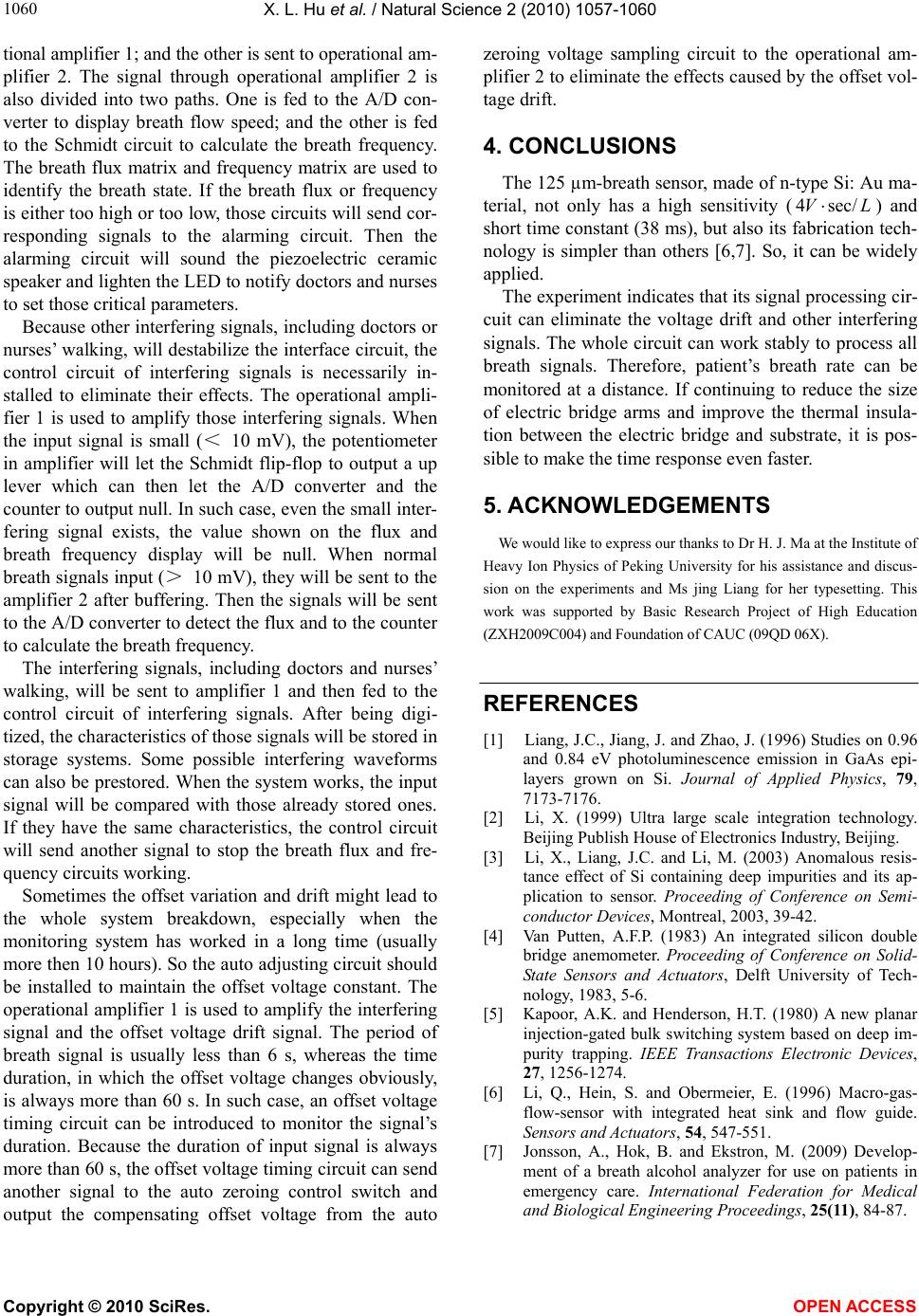
X. L. Hu et al. / Natural Science 2 (2010) 1057-1060
Copyright © 2010 SciRes. OPEN ACCESS
1060
tional amplifier 1; and the other is sent to operational am-
plifier 2. The signal through operational amplifier 2 is
also divided into two paths. One is fed to the A/D con-
verter to display breath flow speed; and the other is fed
to the Schmidt circuit to calculate the breath frequency.
The breath flux matrix and frequency matrix are used to
identify the breath state. If the breath flux or frequency
is either too high or too low, those circuits will send cor-
responding signals to the alarming circuit. Then the
alarming circuit will sound the piezoelectric ceramic
speaker and lighten the LED to notify doctors and nurses
to set those critical parameters.
Because other interfering signals, including doctors or
nurses’ walking, will destabilize the interface circuit, the
control circuit of interfering signals is necessarily in-
stalled to eliminate their effects. The operational ampli-
fier 1 is used to amplify those interfering signals. When
the input signal is small (< 10 mV), the potentiometer
in amplifier will let the Schmidt flip-flop to output a up
lever which can then let the A/D converter and the
counter to output null. In such case, even the small inter-
fering signal exists, the value shown on the flux and
breath frequency display will be null. When normal
breath signals input (> 10 mV), they will be sent to the
amplifier 2 after buffering. Then the signals will be sent
to the A/D converter to detect the flux and to the counter
to calculate the breath frequency.
The interfering signals, including doctors and nurses’
walking, will be sent to amplifier 1 and then fed to the
control circuit of interfering signals. After being digi-
tized, the characteristics of those signals will be stored in
storage systems. Some possible interfering waveforms
can also be prestored. When the system works, the input
signal will be compared with those already stored ones.
If they have the same characteristics, the control circuit
will send another signal to stop the breath flux and fre-
quency circuits working.
Sometimes the offset variation and drift might lead to
the whole system breakdown, especially when the
monitoring system has worked in a long time (usually
more then 10 hours). So the auto adjusting circuit should
be installed to maintain the offset voltage constant. The
operational amplifier 1 is used to amplify the interfering
signal and the offset voltage drift signal. The period of
breath signal is usually less than 6 s, whereas the time
duration, in which the offset voltage changes obviously,
is always more than 60 s. In such case, an offset voltage
timing circuit can be introduced to monitor the signal’s
duration. Because the duration of input signal is always
more than 60 s, the offset voltage timing circuit can send
another signal to the auto zeroing control switch and
output the compensating offset voltage from the auto
zeroing voltage sampling circuit to the operational am-
plifier 2 to eliminate the effects caused by the offset vol-
tage drift.
4. CONCLUSIONS
The 125 µm-breath sensor, made of n-type Si: Au ma-
terial, not only has a high sensitivity (LV sec/4) and
short time constant (38 ms), but also its fabrication tech-
nology is simpler than others [6,7]. So, it can be widely
applied.
The experiment indicates that its signal processing cir-
cuit can eliminate the voltage drift and other interfering
signals. The whole circuit can work stably to process all
breath signals. Therefore, patient’s breath rate can be
monitored at a distance. If continuing to reduce the size
of electric bridge arms and improve the thermal insula-
tion between the electric bridge and substrate, it is pos-
sible to make the time response even faster.
5. ACKNOWLEDGEMENTS
We would like to express our thanks to Dr H. J. Ma at the Institute of
Heavy Ion Physics of Peking University for his assistance and discus-
sion on the experiments and Ms jing Liang for her typesetting. This
work was supported by Basic Research Project of High Education
(ZXH2009C004) and Foundation of CAUC (09QD 06X).
REFERENCES
[1] Liang, J.C., Jiang, J. and Zhao, J. (1996) Studies on 0.96
and 0.84 eV photoluminescence emission in GaAs epi-
layers grown on Si. Journal of Applied Physics, 79,
7173-7176.
[2] Li, X. (1999) Ultra large scale integration technology.
Beijing Publish House of Electronics Industry, Beijing.
[3] Li, X., Liang, J.C. and Li, M. (2003) Anomalous resis-
tance effect of Si containing deep impurities and its ap-
plication to sensor. Proceeding of Conference on Semi-
conductor Devices, Montreal, 2003, 39-42.
[4] Van Putten, A.F.P. (1983) An integrated silicon double
bridge anemometer. Proceeding of Conference on Solid-
State Sensors and Actuators, Delft University of Tech-
nology, 1983, 5-6.
[5] Kapoor, A.K. and Henderson, H.T. (1980) A new planar
injection-gated bulk switching system based on deep im-
purity trapping. IEEE Transactions Electronic Devices,
27, 1256-1274.
[6] Li, Q., Hein, S. and Obermeier, E. (1996) Macro-gas-
flow-sensor with integrated heat sink and flow guide.
Sensors and Actuators, 54, 547-551.
[7] Jonsson, A., Hok, B. and Ekstron, M. (2009) Develop-
ment of a breath alcohol analyzer for use on patients in
emergency care. International Federation for Medical
and Biological Engineering Proceedings, 25(11), 84-87.